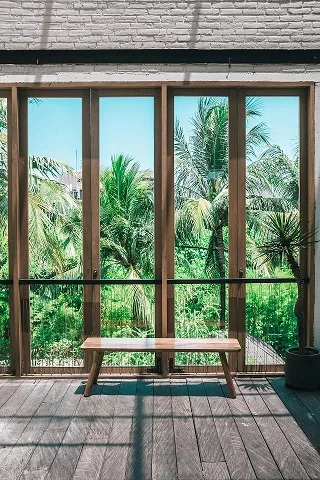
In principle, installation of a toilet bowl on a wooden floor does not have any fundamental differences from installation on a screed. If it is made without violating technology. Problems arise exclusively in the absence of specialized education with a designer or the construction of a cottage. All of them are discussed in detail in the guide on how to install a toilet on a wooden floor on your own!
Features of a wooden floor and wiring of Engineering Systems:
A wooden floor is considered to be either a tongue-and-groove floor or a sub-floor made of plywood, chipboard, edged board. In any of these options, the flooring is mounted on logs (or on beams of wooden floors).
In this case, the sub floor can be tiled with tiles, linoleum, laminate, or any other coating. The self-tapping screws should go through the cladding and screw into the sub floor (or better, into the logs) by 40 mm. Therefore, the first problem to install a toilet bowl in a private house on your own arises from the lack of rigidity of the existing structure:
- Lags are far apart from each other;
- The toilet is supposed to be mounted between them;
- In the place of concentrated load, the boards / sheet material begin to bend.
- The problem is solved exclusively by reinforcing the floor structure with an additional log under the plumbing fixture.
In USA and Europe, the standard for wiring communications is the horizontal arrangement of sewer pipes with their inclusion in vertical risers. Even in a private cottage, the sewer riser does not break off at floor level, but continues upward in the form of a drain pipe passing through the roof, or 30-40 cm to install a vacuum valve that solves a similar task – removing organic decomposition products from a septic tank of an autonomous drainage system.
In other words, the developer does not have any problems with connecting toilets with horizontal flush in principle. When choosing a plumbing fixture with an inclined drain, the height of the internal sewer tee into which the toilet is planned to be connected may be higher than necessary. The most difficult is traditionally the option with a vertical drain, which is much more difficult to connect.
Toilet installation Technology:
Taking into account the above design features of the toilet bowl, wooden floor and sewerage wiring, the installation of a plumbing fixture has nuances. To reduce the budget, it is recommended to choose plumbing, depending on the listed nuances, and apply the appropriate technology.
The choice of Plumbing:
In order for the installed toilet to have normal maintainability, the following nuances should be taken into account when choosing it:
- the standard height of the sides of the toilet seat is 40 cm (it may differ from different manufacturers by a maximum of 5 cm);
- for versions with a horizontal drain, the center of the hole is at a height of 18.5 cm, so the tee for connecting them to the sewer should be slightly lower;
For plumbing fixtures with an inclined drain, the center of the hole is 15 cm from the floor; for normal gravity, a tee is recommended at floor level or not higher than 5 cm from the finishing coating;
Models of toilets with a vertical drain are put on a pipe that goes down through the ceiling, and is rigidly fixed in it with a clamp.
An underground of the required height, inside which it is possible to carry out a sewerage system for a toilet bowl with a vertical drain, is available only in cottages on pile-grillage or column-grillage foundations. For Unclogging tips
For all other options, it is better to choose modifications with a horizontal / inclined drain and apply the standard wiring of engineering systems inside the bathroom – horizontally near the wall with a gravity slope of 4-7 degrees.
The nuances of Horizontal Drain:
It is recommended to install plumbing fixtures on a perfectly flat surface, since sanitary ware is a rather fragile material. The main nuances of installation are:
- During the operation of boardwalks, the boards warp, often have a semicircular transverse “hump” along the entire length of the floorboard;
- Detected flatness defects are eliminated by grinding;
- The wood should be impregnated with an antiseptic, covered with a layer of paintwork materials.
Installation is carried out in the following Sequence:
- Preliminary installation, taking into account the location of the sewerage tee, the water outlet for connecting the cold water supply, the length of the connecting corrugation, the project of the bathroom and the features of the interior of the room;
- Marking the contour of the bottom of the plumbing fixture with a pencil or marker along the perimeter;
- Applying a layer of sealant around the perimeter of the outlined contour and in the center of the bottom of the plumbing fixture (spot with a diameter of 5 – 7 cm);
The final installation of the toilet bowl at the place of operation on the sealant, pressing down with the weight of the master, removing the excess sealing mixture around the perimeter with a damp cloth;
fixing with screws to floorboards or logs through them, decorating hardware hats with special caps;
connection of cold water supply to the drain tank fittings, corrugations to the sewerage tee.
Features of Inclined Drain:
The only difference from the previous method is the connection to the sewer, both during preliminary marking and during final installation:
- The corrugation enters the tee at an angle, therefore, a displacement of several centimeters is possible without preliminary fitting;
After fixing the plumbing body with self-tapping screws, it is much more difficult to install the corrugation, therefore, the maintainability of such modifications is lower if the plumbing is located close to the wall. - Fittings are installed inside the tank before hanging it on the toilet.
- The drain unit is always fastened with a clamping nut from the outside from below, the water intake unit can be located at the bottom or on the side;
- Adjusting the water level and the amount of drain in versions with two buttons are adjusted according to the manufacturer’s instructions.
After installation, the tank and the elements of the plumbing housing should not rest against walls, boxes and false panels. Fixing with self-tapping screws should be carried out with an empty tank.
Specificity of vertical Discharge:
Unlike the previous methods, a toilet with a vertical flush is mounted on a special flange included in the manufacturer’s kit. The flange has a screw connection and retainers that coincide with the counterpart of the plumbing fixture body.
Height adjustments are made before fixing the cabinet to the floor. During normal docking, the master hears a characteristic click. The tightness is ensured by rubber rings, the tank is mounted in a standard way. For Emergency Plumbing Contact here
Do I need Taffeta:
The step-podium of a box-shaped structure made of a board or sheet material (chipboard, plywood, OSB) is called taffeta. This device is recommended to be installed under the toilet, arguing its use for the following reasons:
- Increasing the height of the plumbing fixture – some users are more comfortable with a high toilet seat, the
- Sewer tee may be higher than the outlet of the toilet;
- Protection of the boardwalk from decay – moisture gets on the taffeta, and not on the wooden floor, if the wood decays, this device can be replaced.
Currently, both of these problems are easily solved by constructive methods:
- It is easier to mount plumbing fixtures on the installation by hanging the toilet at the desired height, and at the same time dramatically improving the quality of living and making it easier to clean the toilet with wet cleaning;
- Replacing taffeta is not at all easier than board flooring, plumbing will still have to be dismantled. But the complexity of cleaning increases at the junctions of the step with the floor and the toilet. Access to metering devices and shut-off valves, usually located behind the plumbing fixture makes more difficult.
- Even replacing the high tee of the sewer system with a lower analogue will cost less than making a stand, replacing it regularly, and will solve the problem forever.
Thus, when using a wooden floor in a bathroom, the installation of a toilet bowl is not difficult, in many cases it is cheaper and easier than installation on a screed lined with tiles or porcelain stoneware.
